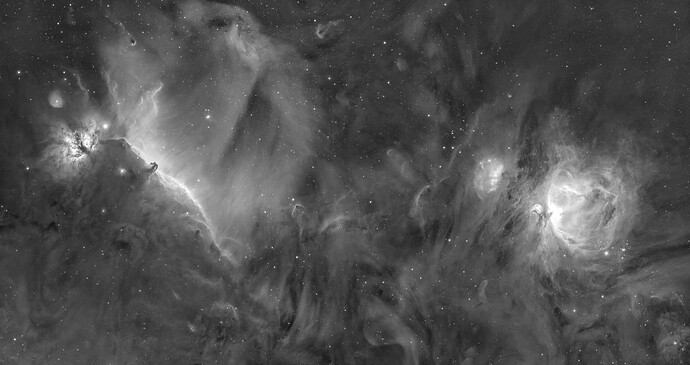3-panel mosaic, Ha channel that I have so far stitched together.
This is an ongoing project.
This is a “small Jpeg”. The size of the real mosaic is 24,000 x 13,000 pixels.
Looking very nice with Ha alone. What other filters are you planning for the mosaic?
Also, what equipment are you using for this project?
Holy moly! This is looking good. What’s the approximate field of view? Maybe something like 8x5 degrees?
I usually do Ha from home, then I’ll go out to a dark site and finish it off with OIII and LRGB.
For big emission nebulae, I like to do a HOO color pallet, then add in LRGB if I can. If I can’t make it to a dark site, I can just use Ha and OIII.
Esprit 100ED refractor reduced to 446mm focal length and F4.3, ASI2600mm pro camera, EQ6r-Pro mount, dithered every frame, 2X drizzled in PIX.
3 panels in “vertical portrait” mode, with about 15% overlap.
I don’t know the exact field of view Russ, it’s 3 panels from left to right.
Andy,
No problem. You are covering a lot of sky with this mosaic in progress. I was just curious if you had a rough estimate of how much.
This has the makings of another fantastic image.
Thanks, Russ, I really appreciate it. And I love all the work you do too. I have a 2-panel mosaic of the belt stars that isn’t quite finished yet. I can give you a sneak peak here:
That is beautiful. Again, covering a lot of sky. Looking forward to the final version. ![]()
![]()
It’s really cool to see the Flame Nebula in the context of its surroundings, all the clouds or dark nebula or whatever. It normally feels like it’s just out of place hanging over black space, but you can really see the anatomy of the surrounding region here.
Very cool, thanks for the info. I’m still new and trying to figure out my direction, very helpful to connect the results and the equipment.
I hope you don’t mind if I throw some thoughts at you about astrophotography gear. I’m using an EOS RP and zoom lens, and trying to figure out what focal length refractor to start with. I know I’ll be in this hobby for a long-haul, and saw the writing on the wall to start with an EQ6R pro, so I can handle a range of scopes. Seeing your work with the Esprit 100 here and on Flickr is helping me confirm that ~500mm FL (plus the option of a reducer) feels like a good place to be for a range of nebulae. I figure 700mm or more might be too much, especially when I move from the full-frame to a smaller DSO sensor eventually. What’s your take on FL for nebulae? Do you ever go after planetary nebula or galaxies with your setup?
Thanks for your time!
Welcome to the club!
I think that a high-quality refractor is always the way to go. It will be with you forever and can do so many things. I use camera lenses and my refractor the most. For smaller targets like galaxies, clusters and planetary nebulae, an Edge HD sct is needed.
Just make sure the refractor has a large corrected imaging circle.
I do like to go after planetary and galaxies, for those we can use the C14 edge out at the observatory.
Thanks for your input! Definitely looking forward to visiting CRO soon.
wonderful picture
Gorgeous!

